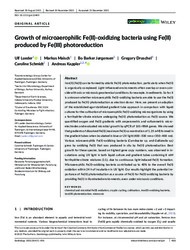Growth of microaerophilic Fe(II)‐oxidizing bacteria using Fe(II) produced by Fe(III) photoreduction
Jørgensen, Bo Barker
Druschel, Gregory
Schmidt, Caroline
DOI: https://doi.org/10.1111/gbi.12485
Persistent URL: http://resolver.sub.uni-goettingen.de/purl?gldocs-11858/9945
Persistent URL: http://resolver.sub.uni-goettingen.de/purl?gldocs-11858/9945
Lueder, Ulf; Maisch, Markus; Jørgensen, Bo Barker; Druschel, Gregory; Schmidt, Caroline; Kappler, Andreas, 2022: Growth of microaerophilic Fe(II)‐oxidizing bacteria using Fe(II) produced by Fe(III) photoreduction. In: Geobiology, Band 20, 3: 421 - 434, DOI: 10.1111/gbi.12485.
 |
View/
|
Iron(II) (Fe(II)) can be formed by abiotic Fe(III) photoreduction, particularly when Fe(III) is organically complexed. Light‐influenced environments often overlap or even coincide with oxic or microoxic geochemical conditions, for example, in sediments. So far, it is unknown whether microaerophilic Fe(II)‐oxidizing bacteria are able to use the Fe(II) produced by Fe(III) photoreduction as electron donor. Here, we present an adaption of the established agar‐stabilized gradient tube approach in comparison with liquid cultures for the cultivation of microaerophilic Fe(II)‐oxidizing microorganisms by using a ferrihydrite‐citrate mixture undergoing Fe(III) photoreduction as Fe(II) source. We quantified oxygen and Fe(II) gradients with amperometric and voltammetric microelectrodes and evaluated microbial growth by qPCR of 16S rRNA genes. We showed that gradients of dissolved Fe(II) (maximum Fe(II) concentration of 1.25 mM) formed in the gradient tubes when incubated in blue or UV light (400–530 nm or 350–400 nm). Various microaerophilic Fe(II)‐oxidizing bacteria (Curvibacter sp. and Gallionella sp.) grew by oxidizing Fe(II) that was produced in situ by Fe(III) photoreduction. Best growth for these species, based on highest gene copy numbers, was observed in incubations using UV light in both liquid culture and gradient tubes containing 8 mM ferrihydrite‐citrate mixtures (1:1), due to continuous light‐induced Fe(II) formation. Microaerophilic Fe(II)‐oxidizing bacteria contributed up to 40% to the overall Fe(II) oxidation within 24 h of incubation in UV light. Our results highlight the potential importance of Fe(III) photoreduction as a source of Fe(II) for Fe(II)‐oxidizing bacteria by providing Fe(II) in illuminated environments, even under microoxic conditions.
Statistik:
View StatisticsCollection
Subjects:
chemical and microbial Fe(II) oxidationcryptic cycling
cultivation
iron(II)‐oxidizing bacteria
iron(III) photoreduction
microoxic
This is an open access article under the terms of the Creative Commons Attribution‐NonCommercial‐NoDerivs License, which permits use and distribution in any medium, provided the original work is properly cited, the use is non‐commercial and no modifications or adaptations are made.

